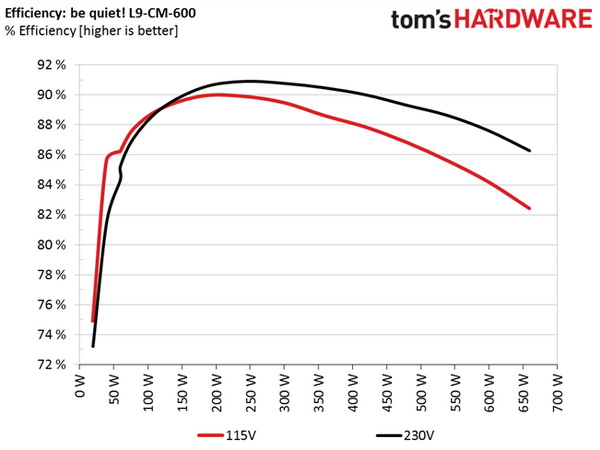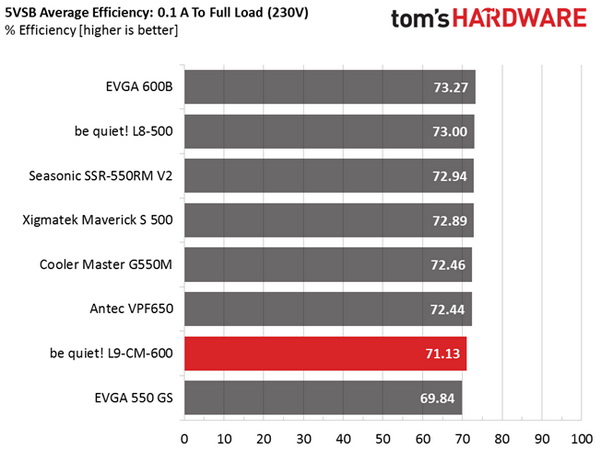be quiet! Pure Power 9 600W PSU Review
be quiet! released the updated Pure Power 9 series that consists of four semi-modular models with capacities ranging from 400W to 700W. Today, we're looking at the 600W implementation to see where it stands in the competitive mainstream market.
Why you can trust Tom's Hardware
Efficiency, Temperature And Noise
Efficiency
Our efficiency testing procedure is detailed here.
Using the results from the previous page, we plotted a chart showing the L9-CM-600W's efficiency at low loads, and loads from 10 to 110 percent of the PSU's maximum-rated capacity.




be quiet!'s latest lands right between the Gold and Bronze units on the average efficiency graph under normal loads, while it passes the Gold-rated Seasonic unit under light loads.
Efficiency At Low Loads
In the following tests, we measure the efficiency of be quiet!'s L9-CM-600W at loads significantly lower than 10 percent of its maximum capacity (the lowest load the 80 PLUS standard measures). The loads we dialed were 20, 40, 60 and 80W. This is important for representing when a PC is idle, with power-saving features turned on.
| Test # | 12V | 5V | 3.3V | 5VSB | DC/AC (Watts) | Efficiency | Fan Speed (RPM) | Fan Noise | PF/AC Volts |
|---|---|---|---|---|---|---|---|---|---|
| 1 | 1.194A | 0.491A | 0.474A | 0.196A | 19.61 | 74.91% | 565 | 17.5 dB(A) | 0.764 |
| 12.200V | 5.016V | 3.365V | 5.037V | 26.18 | 115.1V | ||||
| 2 | 2.422A | 0.988A | 0.979A | 0.396A | 39.74 | 85.63% | 565 | 17.5 dB(A) | 0.786 |
| 12.184V | 5.012V | 3.361V | 5.030V | 46.41 | 115.1V | ||||
| 3 | 3.664A | 1.486A | 1.488A | 5.021A | 59.85 | 86.21% | 565 | 17.5 dB(A) | 0.967 |
| 12.119V | 5.028V | 3.356V | 5.021V | 69.42 | 115.1V | ||||
| 4 | 4.885A | 1.994A | 1.967A | 0.796A | 79.80 | 87.75% | 565 | 17.5 dB(A) | 0.972 |
| 12.120V | 5.020V | 3.352V | 5.013V | 90.94 | 115.0V |
Under light loads, efficiency is high overall, especially if we take into account that this is a Silver-rated unit. The fan is completely inaudible during these tests.
5VSB Efficiency
The ATX specification states that 5VSB standby supply efficiency should be as high as possible, recommending 50 percent or higher with 100mA of load, 60 percent or higher with 250mA of load and 70 percent or higher with 1A or more of load.
We take four measurements: one each at 100, 250 and 1000mA, and one with the full load the 5VSB rail can handle.
Get Tom's Hardware's best news and in-depth reviews, straight to your inbox.
| Test # | 5VSB | DC/AC (Watts) | Efficiency | PF/AC Volts |
|---|---|---|---|---|
| 1 | 0.102A | 0.51 | 70.83% | 0.126 |
| 5.048V | 0.72 | 115.1V | ||
| 2 | 0.252A | 1.27 | 74.27% | 0.232 |
| 5.045V | 1.71 | 115.1V | ||
| 3 | 1.002A | 5.04 | 72.62% | 0.349 |
| 5.027V | 6.94 | 115.1V | ||
| 4 | 3.002A | 14.95 | 72.43% | 0.401 |
| 4.981V | 20.64 | 115.1V |


It's a shame that the 5VSB rail's efficiency is so low. Most likely the lack of a proper PWM controller is to blame.
Power Consumption In Idle And Standby
| Mode | 12V | 5V | 3.3V | 5VSB | Watts | PF/AC Volts |
|---|---|---|---|---|---|---|
| Idle | 12.173V | 5.045V | 3.367V | 5.054V | 6.06 | 0.402 |
| 115.1V | ||||||
| Standby | 0.10 | 0.018 | ||||
| 115.1V |


In the table above, you'll find the power consumption and voltage values of all rails (except -12V) when the PSU is idle (powered on, but without any load on its rails), and the power consumption when the PSU is in standby mode (without any load, at 5VSB).
Power consumption in standby is low, however this isn't enough to allow for high efficiency at 5VSB.
Fan RPM, Delta Temperature And Output Noise
Our mixed noise testing is described in detail here.
The first chart below illustrates the cooling fan's speed in RPM, and the delta between input and output temperature. The results were obtained at 34 °C (93.2 °F) to 47 °C (116.6 °F) ambient temperature.
The next chart shows the cooling fan's speed (again, in RPM) and output noise. We measured acoustics from one meter away, inside a small, custom-made anechoic chamber with internals completely covered in sound-proofing material (be quiet! Noise Absorber kit). Background noise inside the chamber was below 18 dB(A) during testing, and the results were obtained with the PSU operating at 36 °C (93.2 °F) to 45 °C (116.6 °F) ambient temperature.
The following graph illustrates the fan's output over the entire operating range of the PSU. The same conditions of the above graph apply to our measurements, though the ambient temperature was between at 28 °C (82.4 °F) to 30 °C (86 °F).
Up to around 450W, this PSU is almost inaudible. Under higher loads, you will be able to hear it if you're up close.
Current page: Efficiency, Temperature And Noise
Prev Page Load Regulation, Hold-Up Time And Inrush Current Next Page Cross-Load Tests And Infrared Images
Aris Mpitziopoulos is a contributing editor at Tom's Hardware, covering PSUs.
-
turkey3_scratch Really poor unit. For one thing, the crossload performance is poor. Sleeve bearing fan with less reliability. 85C primary capacitor. Once again, another failed 3.3V transient response. Very high inrush current. Also, near worst of all, 140+mv of ripple on the 12V rail in CL2. Just really bad. And CL2 is a realistic scenario these days because those 3.3V and 5V rails don't do much anyway. FSP's soldering is clearly not the same as the nice soldering on their high end units.Reply
But my largest complaint would have to be voltage regulation (line regulation) under different load scenarios on page 6. -
4745454b 85C main cap doesn't bother me that much. It should get airflow from the fan so unless the fan dies (and if it does 105C cap isn't going to help much.) or it gets clogged with dust you should be ok. As for the CL test what do you expect? It's a group regulated design so that's going to happen. It's like buying a super duty truck and then complaining you don't get 30MPG in town. What I find more bothersome is they can't seem to sell you what they claim on the box. If it's not C6 or C7 ready and not a group reg design, why claim so? I wonder if they shipped the wrong unit?Reply -
powernod Outstanding review by Aris as always! :)Reply
If only the PSU itself was outstanding as well:ouch:
-
basroil Looks like FSP is still mostly a second tier manufacture with those transient response and inrush... does it really hurt that much to put a shuntable thermistor like Seasonic and SuperFlower units have?Reply
For less than $10 more you can usually find excellent Seasonic and SuperFlower Leadex Gold units, which makes it really hard to say this PSU is anything more than "meh" -
Aris_Mp actually I am worried about the bulk cap, because 85C means that it has 4x times lower lifetime than a 105C cap.Reply -
turkey3_scratch Reply17839248 said:85C main cap doesn't bother me that much. It should get airflow from the fan so unless the fan dies (and if it does 105C cap isn't going to help much.) or it gets clogged with dust you should be ok. As for the CL test what do you expect? It's a group regulated design so that's going to happen. It's like buying a super duty truck and then complaining you don't get 30MPG in town. What I find more bothersome is they can't seem to sell you what they claim on the box. If it's not C6 or C7 ready and not a group reg design, why claim so? I wonder if they shipped the wrong unit?
Not all group regulated designs are exactly the same way. We see in Seasonic's S12ii series a group regulated design that actually crossloads very well. This seems to be one of the worst on the ladder.
@Aris: Why is Inactive PWR_OK to DC_LOSS better at a higher value? Once the PWR_OK signal is dropped, wouldn't you want the unit to shut down as quickly as possible, not prolong it? -
powernod It was already explained by Aris at his review:Reply
"The power-good signal lasts longer, so when it drops, the voltage level of the +12V rail is already below 11V."
When the pwr_ok to DC_loss is higher (*meaning that it has a positive , not negative value) that means that the motherboard will already have been shut-down. (*from what i've understand, at least) -
turkey3_scratch Not sure how the motherboard could shut down before the PWR_OK signal is dropped.Reply -
Aris_Mp the problem is that in some PSUs, PWR_OK, which informs the mainboard when it should shut down, drops after and not before the rails go our of spec. So once it drops the rails are already too low.Reply
Normally when AC is removed, the PWR_OK signal should be de-asserted at least 1ms before voltages go out of spec in order not to stress the VRMs of the mainboard and of other components (e.g. VGA, HDD, SSD, etc.).
The only way to address this issue is to have a circuit on the mainboard checking the input voltages and give the shut down order when these go out of spec. In other words to completely bypass the power_ok signal coming from the PSU. But this will cost money and after all a PSU oughts to follow ATX spec's guidelines. -
turkey3_scratch So is "DC_LOSS" considered "voltages out of spec"? I mean, there can still be DC even if voltages are out of spec. It won't be a loss of DC< just an out-of-spec voltage relative to the DC.Reply


